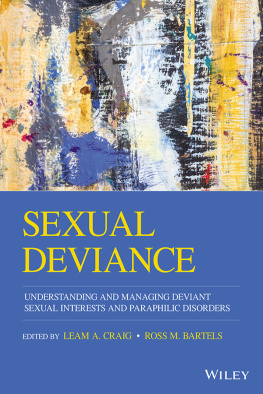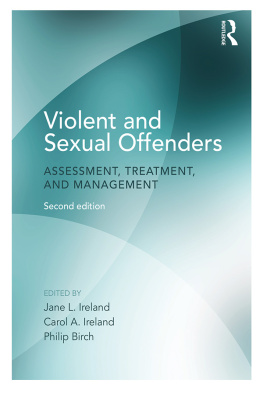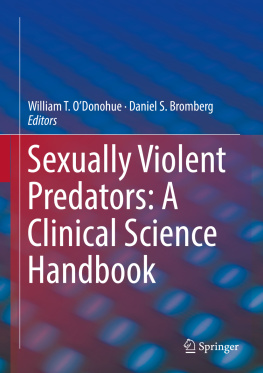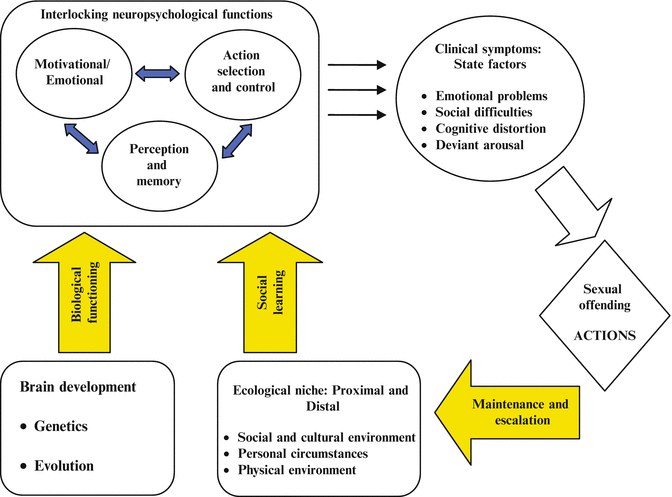We offer to read an annotation, description, summary or preface (depends on what the author of the book "Sexual Offending: Predisposing Antecedents, Assessments and Management" wrote himself). If you haven't found the necessary information about the book — write in the comments, we will try to find it.
An Integrated Theory of Sexual Offending -- Part I: Disorders and Types of Sexual Offending -- Pedophilia -- Hebephilic Sexual Offending -- Rape and Paraphilic Coercive Disorder -- Drug Facilitated Sexual Assault -- Non-Contact Sexual Offenses: Exhibitionism, Voyeurism, Possession of Child Pornography and Interacting with Children Over the Internet -- Hypersexuality Disorder -- Personality, Motivators and Disinhibition in Sexual Offending -- Adolescents Who Have Engaged in Sexually Abusive Behavior: An Overview -- Female Sex Offenders -- Part II: Assessment and Risk Appraisal of Sexual Offenders -- Assessment, Diagnosis and Risk Management of Sexual Offenders with Intellectual Disabilities -- Issues and Methods in Assessment -- Clinical Strategies for Evaluating Sex Offenders -- Structured Psychological Assessment -- Psychophysiological Assessment of Sexual Preferences -- Principles and Practices of Forensic Evaluations of Sexual Offenders -- Conceptual Model of Risk versus Threat and Risk Management versus Risk Reduction -- Risk Factors and Risk Assessments for Sexual Offense Recidivism -- Overview of the Development, Reliability, Validity, Scoring, and Uses of the Static-99, Static-99R, Static-2000, and Static-2002R -- Sex Offender Base Rates of Sexual Recidivism after Controlling for Static-99/R -- The Sex Offender Risk Appraisal Guide (SORAG) -- The Minnesota Sex Offender Screening Tool-3.1 (Mnsost-3.1) -- Structured Risk Assessment -- Beyond Static Risk Assessments? Assessment of Psychologically Meaningful Risk Factors via STABLE-2007 and the SRA: FV -- Assessing Sexual Violence Risk and Evaluating Change with the Violence Risk Scale-Sexual Offender Version -- Structured Professional Judgment: Applications to Sexual Offender Risk Assessment and Management -- Part III: Management and Public Policy Issues Regarding Sexual Offenders -- Models of Sexual Offender Treatment -- Forensic Psychotherapy for Sexual Offenders: Has its Effectiveness Yet Been Demonstrated? -- Forensic Psychotherapy for Sexual Offenders: Likely Factors Contributing to Its Apparent Ineffectiveness -- The Containment Approach: A Strategy for Community Management of Sex Offenders -- Circles of Support & Accountability: The Role of the Community in Effective Sexual Offender Risk Management -- Pharmacotherapy for Sexual Offenders -- Surgical Castration and Sexual Recidivism Risk -- Civil Commitment of Sex Offenders likely to Reoffend -- Prosecutor; Perspective on Sexually Violent Predator Cases -- Sexually Violent Predator Law From the Defense Perspective -- Reconciling Sex Offender Management Policy, Research, and Practice -- An Evidence-Based Perspective on Sex Offender Registration and Residential Restrictions.;This expert reference provides a broad, comprehensive review of the major domains concerning sexual offending. Beginning with a general etiological model of sexual offending, chapters follow addressing the primary predisposing conditions related to sexual offending (e.g. pedophilic, hebephilic, paraphilic rape and non-contact paraphilic disorders, hypersexuality and personality-related factors. In addition, special subgroups of sexual offenders (females, youth and the intellectually disabled) are considered. Both broad and specific perspectives on the assessment of sexual offenders are provided. Several perspectives are offered on so-called clinical evaluations of such offenders, including the central utility of structured psychological assessment approaches. A detailed chapter is provided on the principles and practices regarding the great majority of evaluations of sexual offenders that are actually forensic in nature. Considerable emphasis is focused on scientific risk assessment for sexual offending, including a novel conceptual model of risk and threat assessment. More specifically, each of the primary approaches or instruments developed for the risk assessment of future sexual offending are addressed including the Static risk measures, the Sex Offender Risk Appraisal Guide, forms of Structured Clinical Judgment, and varied measures of dynamic or criminogenic needs assessments. Finally, multiple aspects related to the management of sexual offenders are discussing including contemporary models of psychosocial treatments, the question of effectiveness of such treatments, biological interventions, civil commitment, circles of support and the containment approach to community management. A distinctive feature of this book is that chapters are authored by both prominent international experts and experienced; practicing professionals to best provide a breadth of useful perspective. Among the topics covered: Pedophilic, Hebephilic, Rape Paraphilic Disorders and the variety of Non Contact sexual offending conditions Personality, related conditions, & their association with sexual offending: motivators and disinhibition in context. Disorders of hypersexuality. Assessments of sexual offenders, including the role of psychological testing, clinical & interview approaches, as well as forensic evaluations Conceptual models of risk assessment & discussion of specific static, dynamic & structured clinical risk assessment approaches Models of & reviews of treatment outcome with sexual offenders, including psychotherapy, psychopharmacology and castration, the containment approach, civil commitment & circles of support Overview of public policy issues & an evidence-based perspective on sex offender registration and residential restrictions. This breadth of material in Sexual Offenders will help practitioners gain multiple levels of clinical insight as well as giving them up-to-date practical tools and techniques for working with this problematic class of individuals.







